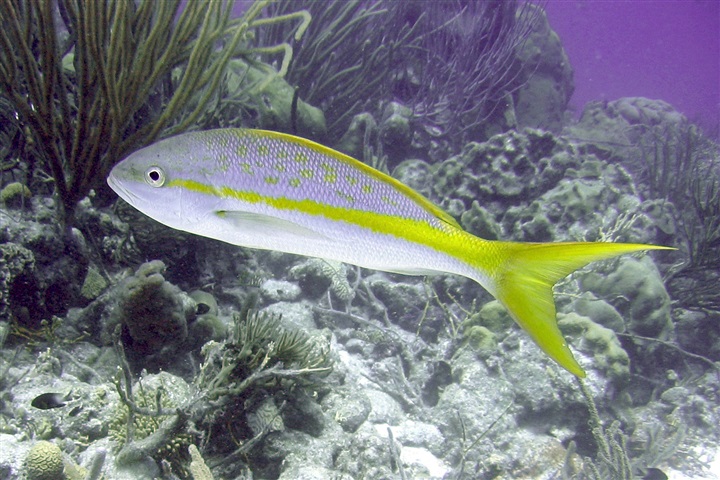Ocyurus chrysurus

| Latin name | Ocyurus chrysurus |
|---|---|
| Local name | Yellowtail snapper |
| Family | Lutjanidae - Ocyurus |
| Origin | The Mexican Golf, West Atlantic |
| Max length | 86 cm (33.9") |
| Minimum volume |
5000 l (1319 gal) |
|---|---|
| Hardiness |
Average |
| Suitable for aquarium |
Suitable with care |
| Reef safe |
Reef safe with caution |
| Aggressiveness | Unknown |
| Recommended |
Fish Larger crustaceans (Shrimp, crabs...) Small crustaceans (Krill, mysis, artemia...) Zooplankton (Cyclops, pods...) |
|---|
This species grows very quickly if fed well.
This spicies might be a threat to smaller fishes.
This species poses a threat towards shrimps and crabs etc., which are relatively small.
There is little available knowledge of this species, so there can be important information missing on this page.
This species needs a very large aquarium when fully grown.
Exactly how big the aquarium should be is hard to say, but the size of this species is such, that it cannot normally be kept in a home aquarium.
This species must be fed with an appropriately varied diet.
This species eats a great deal and demands an aquarium that can tolerate such a heavy load.
This fish requires feeding several times a day, especially when newly added.
When the fish can find its natural food in the aquarium it requires less frequent feeding.
This species thrives best in an aquarium with overhangs and caves.
This species revels in swimming and requires an aquarium with ample space.
Snappers (Lutjanidae) are predatory fish, which normally live off fish and a wide range of invertebrates; typically crustaceans, but also snails, sea urchins, worms etc. They will mostly find their food on the bottom, and some species will blow in the sand to find food.
Unlike the other species, species in the Macolor, Pinjalo and Rhomboplites genera live of the larger kinds of zooplankton.
Snappers are generally fairly hardy, but are only suitable for very large aquaria. One should arrange the tank, with a large overhang or hole where they can hide.
Scott W. Michael. 2004. Angelfishes and Butterflyfishes (Reef Fishes Series Book 3) TFH Publications / Microcosm Ltd. - (English)
Bob Fenner. Snappers, Family Lutjanidae - Wet Web Media - (English)
WWM Crew. FAQs about Snappers, Family Lutjanidae - Wet Web Media - (English)

